
|   |

|   |
Mudra National Dance Festival 2013 Text & pics: Hareesh N. Nampoothiri e-mail: newn.haree@gmail.com December 8, 2013 Six days, eight dance forms and twelve artists – the bouquet of this year's Mudra National Dance Festival (Nov 23 – 28) at Thiruvananthapuram had the variety that a dance festival can possibly offer. The opening day of the festival featured Bharatanatyam by Nikolina Nikoleski and Mohiniattam by Pallavi Krishnan. Nikolina Nikoleski Nikolina Nikoleski, born in Croatia and currently settled in New Delhi, is a disciple of Bharatanatyam guru Saroja Vaidyanathan. The practice she had in classical ballet and gymnastics certainly helped her to make those leg stretching moves and balanced postures look effortless. However, her exposure to those seem to have some adverse effect as her footwork at times lacked the aesthetic beauty that one would expect in Bharatanatyam. The nayika's yearning for Krishna in the Dhanyasi varnam "Nee indha maayam..." failed to impress as she hurried through the abhinaya sequences and the hand-eye coordination was often relaxed. On the other hand, “Bho Shambho...” (Revathi / adi) and the Desh Thillana depicting Anjaneya were apt picks for her style in which she did much better. Considering the fact that Nikolina is coming from a different cultural background, she surely deserves appreciation. But, as far as her Bharatanatyam alone is concerned, the performance here suggests that it requires further polishing. Nikolina had Sreedev Rajagopal (vocal), Madhavi Chandran (nattuvangam), Anish K. Vasudevan (mridangam) and Thirunelloor Ajithkumar (violin) as her accompanying members. 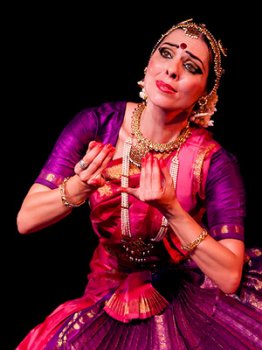 Nikolina Nikoleski 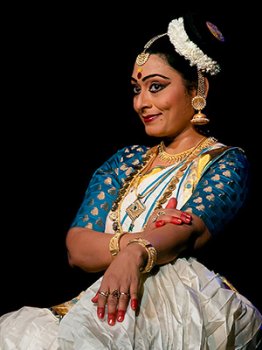 Pallavi Krishnan Pallavi Krishnan As the inaugural session stretched much longer than expected, Pallavi Krishnan was forced to make her recital short. Apart from the introductory Cholkettu piece and Mangalam she only had time to present ‘Pingala,’ the central piece. Penned by Namamangalam Madhavan Namboothiri and music set by Palakkad K. Suryanarayanan along with Nedumpally Ram Mohan, this piece narrates how the prostitute Pingala turned into an ardent devotee of Rama. Choreographed by her, Pallavi was fluent in her presentation; but whether the presentation had enough to captivate the audience was rather doubtful. The use of too many instruments in the background (that too in an awfully mixed state, through poorly arranged speakers) did not favor the dancer. The team had Prasanth Parasini in vocal, Kallekulangara P. Unnikrishnan on mridangam and maddalam, Palakkad Suryanarayanan on flute, Murali Krishna on veena, Kalamandalam Arun Das on edakka, and Kalamandalam Sheena on thalam. Sruthy Jayan Sruthy Jayan was at her best during her Bharatanatyam recital on the second day. Having been connected with Kalakshetra for many years, as a student and later as a teacher, her recital featured some of the unique pieces blossomed in the institute. In the introductory Karpaka Vinayaka Sthuti itself she was able to make an impression. Swati Thirunal's “Sankara Srigiri...” (Hamsanandi / adi) followed in which she portrayed the dancing Shiva. The splendid choreography provided a lot of opportunity to display one’s competency in the adavus as well as the techniques and Sruthy was seen making the best use of it. The dynamics that she generated through her precise footwork and varied expressions marked elegance. ‘Murugan Thalattu’ was the piece that followed in which she portrayed an affectionate mother. “Panthadi Thanale...” (Tilak / tisra chapu), a piece from Kutrala Kuravanji, one of the earlier productions of her alma mater, and Kalakshetra's own Nadabhairavi Thillana also bore the sign of her finesse. Sreedev Rajagopal on vocal and Sreerang on mridangam did their best, and along with Aparna Sundharam (nattuvangam) and Sangeeth Mohan (violin) contributed well to the performance. 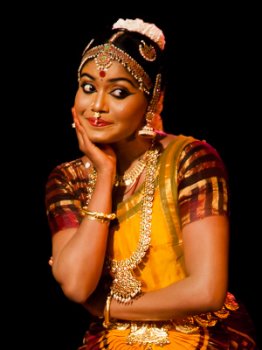 Sruthy Jayan 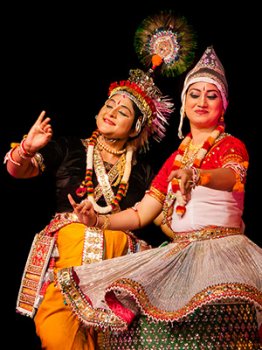 Sruti Bandopadhyay and team Sruti Bandopadhyay and team A performance so lively and engaging, Sruti Bandopadhyay and her team succeeded in pulling out a profound display of Manipuri dance. After a short solo Mangalacharan piece by Sruti, they moved on to ‘Balya Leela,’ a three segment choreography piece portraying Krishna's antics. Sruti was seen in the roles of Yashoda, Kaliya and later in the concluding ‘Vasantha Rasa’ as Krishna himself. Debangana Chakravorty was the other dancer in lead and she portrayed Krishna in the former segments and that of Radha in the latter. The dancers' smooth paced undulate movements and joyous expressions made the recital a treat to watch. Moreover, they were dressed in colorful costumes unique to Manipuri dance, which include cylindrical mirrored skirts, gossamer veils and fascinating head gears, and the visual richness dazzled the audience. The pung players and the rest of the accompanying members also deserve credit for their ample support and for the music ensembles that they presented during the intervals. Vijayalakshmi The third day started with Mohiniattam by Vijayalakshmi. As the daughter and premier disciple of Bharati Shivaji, Vijayalakshmi is known for her endeavors in pushing the boundaries of the dance form. The opening piece titled ‘Ganapathy Sthuthi’ (Kavalam Narayana Panicker / Ragamalika / Talamalika) was inspired from ‘Parvati Viraham’ and ‘Kailasodharanam,’ oft seen in Koodiyattam and Kathakali. Though the piece had its uniqueness and lot of substance, Vijayalakshmi’s expressions often looked naive and the choreography failed to create interest. ‘Ram Charith Manas’ telling the story of marriage between Rama and Sita also couldn't generate that kind of a charm. ‘Mukhajalam’ and ‘Thouryathrika’ were two pure dance pieces, the latter being inspired by the percussion ensembles such as Panchavadyam and Thayampaka. Like the earlier evening, the harmony between the horde of instruments was lacking. Rajagopalan (vocal), Jayan P. Das (mridangam and maddalam), Kalamandalam Sreekumar (edakka), Sundar Raj (veena) and Sankaranarayanan (flute) formed the music ensemble.  Vijayalakshmi 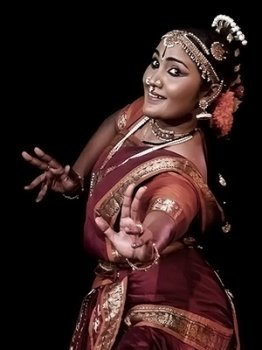 Sreelakshmy Govardhanan Sreelakshmy Govardhanan Sreelakshmy Govardhanan was at complete ease throughout the performance following the traditional approach of Kuchipudi which had live dialogues in between. After the Pushpanjali (Bihag / adi) she moved on to the central pieces – ‘Mandodari Sabdam’ and ‘Bhama Kalapam.’ How the mandookam gets deliverance from the curse, becomes Mandodari and ends up being the wife of Ravana being the gist of the former, Sreelakshmi’s recital was laced with elegant footsteps, stylized postures and a flurry of varied expressions. She chose to perform the first two daruvus of ‘Bhama Kalapam’ which had Bhama telling her friend Madhavi about her husband Krishna. With a touch of humor, Sreelakshmy acted the role of Bhama to perfection. Vidya Sundari, herself being a performer, was precise in nattuvangam and also managed well to recite the dialogues. Nandakumar at his emotional best in vocal, Sivaprasad doing well on mridangam and Sangeeth Mohan playing his part on violin, Sreelakshmy had the necessary support from her accompanying artistes. “Nanda Nandana...” tarangam from Narayana Teertha’s Sri Krishna Leela Tarangini was the concluding piece in which she also performed on the brass plate balancing a pot of water on her head. Purvadhanashree The fourth day of the festival saw Purvadhanashree’s Vilasini Natyam, a dance form rarely staged in these parts. In contrast with Kuchipudi, Vilasini Natyam follows the Sthree Sampradayam in which movements appear quintessentially feminine. She opened with ‘Vinayaka Prarthana,’ an invocation piece in which Purva was seen at ease making those stylized movements and made it look distinct from other dance forms. Choornika, offering pushpanjali to various deities and a Swara Pallavi (Kalyani / adi) followed in which the peculiar adavus got further embellished. Sreedharacharya on mridangam could have done better as he was often found a bit late in following the dancer. However the rest of the team, Renuka Prasad (nattuvangam), Sweta Prasad (vocal) and Kadanad Haridas (violin), ably supported the dancer. A short ‘Salam Daravu’ (Mohanam / adi) piece was presented next and she concluded with Doothika Varnam (Todi / rupaka), in which she portrayed the sakhi, who has been sent by the nayika as a messenger to the king. 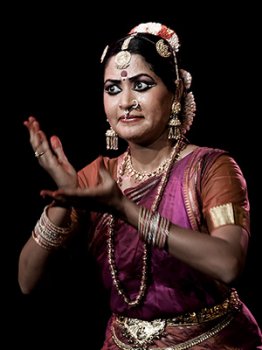 Purvadhanashree 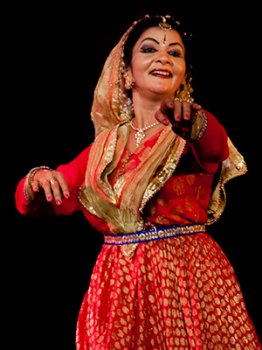 Shila Mehta Shila Mehta Kathak performer Shila Mehta started with upaj, thaat and a few thukdas. She initially struggled to find the flow along with her percussionists. The jugalbandhi between the dancer and Pandit Kalinath Misra on tabla also couldn’t really elevate to the levels that one would expect. Somnath Misra (vocal and harmonium), Prasad Ramu (sitar) and Sreekumar (flute) formed the rest of the orchestra. Rendition of 'Sitapaharan' and 'Navarasa' keeping in tune with the rhythm, were the two short pieces that grabbed the attention of the viewers. In the abhinaya piece, the love of Radha was portrayed based on Jayadeva’s Gita Govindam. She then moved on to a few taranas, in which she did the chakkars to perfection and a Holi dance. These concluding pieces were the show savers that delighted the spectators. Ileana Citaristi The fifth day of the festival had Ileana Citaristi, the Italy-born dancer and choreographer performing Odissi. After a well choreographed Mangalacharan piece in praise of Lord Surya, she moved on to the Pallavi (Bhimpalasi / ektali) item in which she made those soft eye and torso movements marked to perfection. The abhinaya piece titled ‘Saranam’ had its uniqueness when she presented women from three faiths (Mary Magdalene, Amrapali and Pingala), woven together focusing on how the icons of these faiths (Jesus, Buddha and Krishna) transformed them to find their inner self. Maybe Ileana was a little weary in her footsteps at times, but her expressions stayed poised throughout the narration. She was very well supported by Budhanath Swain on mardala and also had ample support of Binod Pandae in vocal and Ramesh Das on violin. Ileana concluded with 'Navarasa', a piece choreographed by her guru Kelucharan Mohapatra. 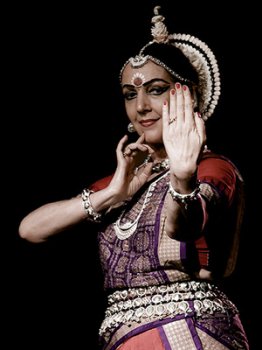 Ileana Citaristi 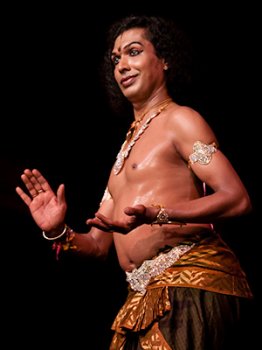 Jolly Mathew Jolly Mathew The Bharatanatyam recital by Jolly Mathew was mediocre at best, apart from the display of some masculine karanas. Vocalist Nandakumar’s soulful rendering made it worth it to sit through the performance. Kalamandalam Subin Raj (nattuvangam), Kalamandalam Kiran Gopinath (mridangam) and Sangeeth Mohan (violin) formed the rest of the team. Janaki Rangarajan A performance that every spectator would cherish for long, Janaki Rangarajan danced her soul out during her Bharatanatyam recital on the final day. After the Alarippu and ‘Sivoham’ she moved on to the central piece, the Ragamalika varnam “Sami Ninne Korinarura...” in Rupaka talam. She was flawless throughout the presentation with admirable stage presence as she presented the full-length varnam. The abhinaya was sedate and gentle enabling the audience to have a good grasp of every detail. The way she narrated the story of Markandeya and elaborated other sequences underlined her versatility over the medium. Jathis, done by the dancer herself, were never stretched beyond acceptable limits and it helped her to maintain the sthayi in tact all along. Kaniyal Hariprasad’s highly rich rendering and V. Vedakrishnaram's thoughtful efforts on mridangam supplemented the dancer in every possible way. The other accompanying members were Jayashree Ramanathan on nattuvangam and Thiruvizha Viju S. Anand on violin. Janaki was seen hardly making any moves in the next piece, yet holding the attention of the viewers through her subtle but intense mukhabhinaya in “Kuruyadunandana...,” the last ashtapadi from Jayadeva’s Gita Govindam. Thillana in ragam Poorvi describing the beauty of Saptaswaras and Pranavakara was the final item. 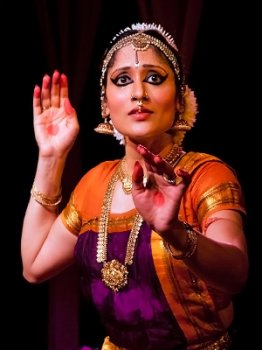 Janaki Rangarajan 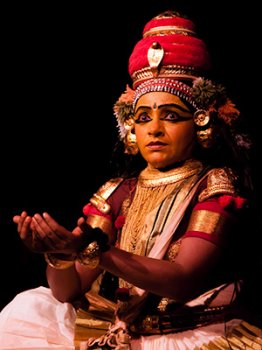 Kapila Venu Kapila Venu After such a Bharatanatyam extravaganza, it was not an easy job for any performer to make an impression. Kapila was up to the task and made her Nangiarkoothu recital equally profound. The story for the day was ‘Kurmavatara.’ After presenting the situation of the story in brief, Kapila moved on to the gist of the segment – the churning of Palazhi. The portions to elaborate was wisely chosen keeping in mind the time she had for the presentation. The massive size of Mountain Mandara, the lifting of the mountain, Lord Vishnu taking the form of Kurma to support the mountain and the churning of the ocean were the scenes which were detailed. The act was truly enchanting which marked her mastery in the abhinaya aspects of the art form. However, she could have reflected the enormous size of serpent Vasuki as well in the above renditions which would have made it more effective in totality. Kapila was accompanied by Kalamandalam Rajeev and Kalamandalam Jayaraj on mizhavu, Kalanilayam Kaladharan on edakka and Margi Usha on talam. The festival was jointly organized by Vyloppilly Samskrithi Bhavan and Dept. of Cultural Affairs, Govt. of Kerala. Hareesh N Nampoothiri is a visual design consultant by profession and a lover of classical art forms. Being an ardent follower of Kathakali, he conceptualized and directed a documentary on Kathakali titled 'Thouryathrikam,' which introduces the nuances of Kathakali to the common man. Writing and photography are his other passions. |